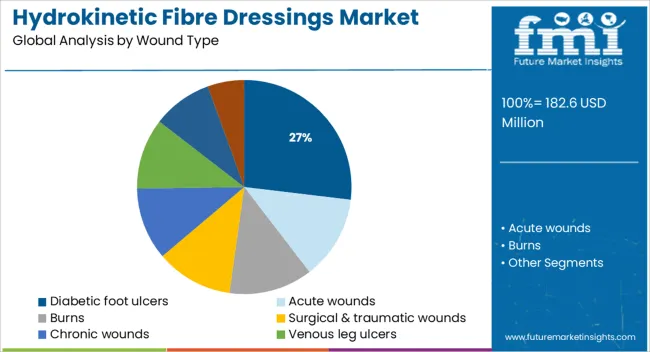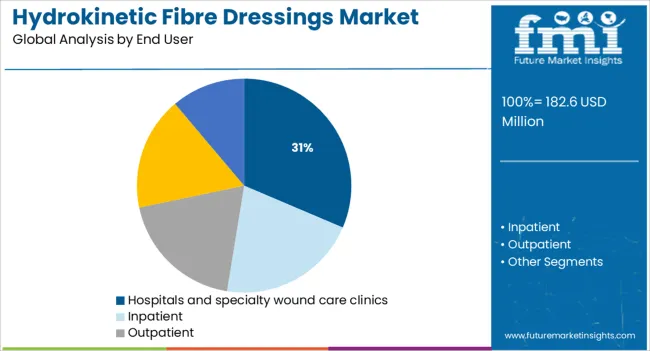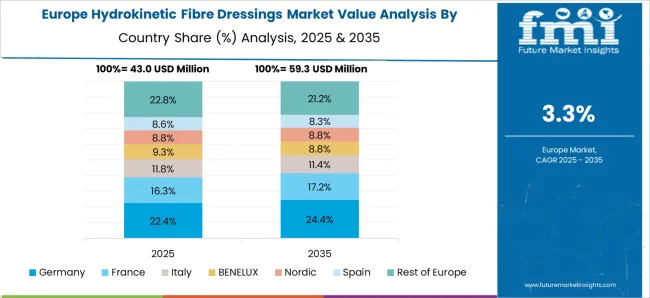The Hydrokinetic Fibre Dressings Market is estimated to be valued at USD 182.6 million in 2025 and is projected to reach USD 260.0 million by 2035, registering a compound annual growth rate (CAGR) of 3.6% over the forecast period.

| Metric | Value |
|---|---|
| Hydrokinetic Fibre Dressings Market Estimated Value in (2025E) | USD 182.6 million |
| Hydrokinetic Fibre Dressings Market Forecast Value in (2035F) | USD 260.0 million |
| Forecast CAGR (2025 to 2035) | 3.6% |
The hydrokinetic fibre dressings market is undergoing steady expansion, driven by growing clinical emphasis on moisture management, exudate control, and infection prevention in chronic wounds. These dressings are increasingly being adopted due to their ability to create an ideal wound healing environment by managing high levels of wound exudate while maintaining structural integrity.
Advances in wound care technology have allowed hydrokinetic fibre dressings to deliver better fluid handling and absorption capacities compared to conventional dressings. Healthcare systems worldwide are prioritizing cost-effective solutions that reduce dressing change frequency and minimize hospital-acquired infections, thus enhancing the relevance of hydrokinetic options.
In addition, the prevalence of chronic conditions such as diabetes and vascular diseases has contributed to the rising incidence of hard-to-heal wounds, creating greater demand for specialized dressings Integration of clinical guidelines that favor advanced wound management therapies and the increasing availability of such products across hospital settings and wound care centers are expected to support continued market growth.
The market is segmented by Wound Type and End User and region. By Wound Type, the market is divided into Diabetic foot ulcers, Acute wounds, Burns, Surgical & traumatic wounds, Chronic wounds, Venous leg ulcers, Pressure ulcers, and Other chronic wounds. In terms of End User, the market is classified into Hospitals and specialty wound care clinics, Inpatient, Outpatient, Long-term care facilities, and Home healthcare. Regionally, the market is classified into North America, Latin America, Western Europe, Eastern Europe, Balkan & Baltic Countries, Russia & Belarus, Central Asia, East Asia, South Asia & Pacific, and the Middle East & Africa.

Diabetic foot ulcers are expected to account for 26.9% of the hydrokinetic fibre dressings market revenue share in 2025, driven by the rising global prevalence of diabetes and associated complications. The demand for hydrokinetic fibre dressings in this wound type has been influenced by their ability to effectively manage high exudate levels and reduce the risk of secondary infections.
In diabetic patients, impaired wound healing mechanisms and compromised circulation require advanced solutions that maintain moisture balance without causing maceration. These dressings have demonstrated strong efficacy in supporting autolytic debridement and minimizing wound edge deterioration, which is critical in chronic ulcer cases.
Their non-adherent properties and structural resilience reduce the risk of dressing fragmentation within the wound bed, a common concern in diabetic ulcers The ability to support wound progression toward closure while reducing the frequency of dressing changes has positioned hydrokinetic fibre dressings as a preferred intervention within diabetic foot care protocols across acute and community care settings.

Hospitals and specialty wound care clinics are projected to represent 31.4% of the hydrokinetic fibre dressings market revenue share in 2025, underscoring their role as primary treatment hubs for chronic and complex wounds. The increased use of hydrokinetic fibre dressings in these settings is attributed to the demand for high-performance solutions capable of managing variable exudate volumes in post-operative and non-healing wounds.
Clinicians have shown preference for dressings that maintain integrity during wear time and offer consistent moisture control, reducing the incidence of dressing-related trauma during removal. In hospital environments, infection control remains a top priority, and hydrokinetic fibre dressings offer an effective barrier against contaminants while supporting healing progression.
Their inclusion in wound care protocols and treatment pathways in specialized clinics has been reinforced by clinical outcomes that demonstrate improved healing rates and patient comfort The availability of skilled wound care personnel and the integration of advanced dressing options in formulary guidelines have further cemented the presence of hydrokinetic fibre dressings in institutional care settings.
The older population and the expanding demands in the biotechnology industry are the primary drivers of the market for hydrokinetic fiber dressings. The market's expansion is also fueled by the healthcare industry's evolving trends, tightening regulations, and growing emphasis on cost-cutting measures, all of which have raised the rate at which various healthcare institutions are adopting hydrokinetic fiber dressings.
The incidence of chronic diseases has increased along with the number of treatments done. Hydrokinetic fiber dressings are therefore being utilized more frequently to stop postoperative complications. Most surgical wounds created by cancer surgery are large and deep, producing exudates that must be regularly controlled. Large wounds could be managed with these dressings, greatly reducing the danger of infection. As a result, the rising incidence of chronic illnesses would fuel demand for hydrokinetic fiber dressings and propel market growth.
Other reasons driving the market's expansion include the development of the healthcare infrastructure, a greater emphasis on eradicating diseases brought on by wounds, and the creation of contaminant-free environments. Lastly, in wound care, standards are being raised to ensure that wounds receive excellent care, which will accelerate market expansion.
Prominent factors that might limit the growth of the global market include the high cost of active wound care therapies as well as the high cost of complex wound dressing technology items and equipment. Although these dressing treatments for wounds and burns are quite efficient, they are also very expensive. Since not everyone can afford these costs, hydrokinetic fiber dressings' expansion on the worldwide market is being restrained.
The greatest challenge in the global industry is also the stress of competitive pricing. The price of the top rivals is very competitive, which disrupts the world market. The total CAGR is anticipated to decrease if the same scenario holds true throughout the projection period.
North America is currently leading the hydrokinetic fiber dressing industry. According to Future Market Insights Analysts, North America's hydrokinetic fiber dressings market is likely to reach a global market size of 39.9% by 2025. The rising use of hydrokinetic fiber dressings, adequate skilled individuals and well-developed healthcare infrastructure, and the rise in the number of biotechnology and pharmaceutical firms operating in this region all contribute to the market's expansion.
The region is anticipated to grow at a notable rate of 3.5% throughout the predicted period. The regional market for hydrokinetic fiber dressing is anticipated to grow due to rising traffic accidents, sports injuries, and multiple important businesses in the region.

With consistent expansion, Europe will represent around 30.0% of the worldwide market share by 2025. In Europe, there are several different types of wound care clinics. In Specialty Wound Care Clinics, hydrokinetic fiber dressings are utilized to speed the recovery of both acute wounds and chronic burns. They aid in eliminating extra fluid from wounds and encourage cell growth. This can speed up healing and improve the patient's overall prognosis.
The growth in Europe is anticipated to increase due to the increase in patient visits to these clinics during the forecast period. The large market share of hydrokinetic fiber dressings held by Western Europe is the result of factors such as an aging population, an increase in the prevalence of chronic and acute wounds, rising healthcare costs with higher disposable income, and the existence of significant market players.
Throughout the forecast period, Asia Pacific is anticipated to have the quickest growth in the hydrokinetic fiber dressings market. Developing nations like Japan, China, and India are anticipated to boost market expansion in the area. The rapidly growing medical tourism industry in these nations is also a result of the rising need for hydrokinetic fiber dressings in the area.
India had 58,300 medical tourists on medical visas from 2020 to 2024, according to the Directorate-General of Commercial Intelligence and Statistics of India's report on Export Health Services. Throughout the forecast period, such events are anticipated to strengthen the Asia Pacific market.
In response to the expansion of the healthcare infrastructure, the hydrokinetic fiber dressing market has become increasingly fragmented and competitive. As a result, startups are attempting to stand out from established market competitors to attract clients through technological inventions.
Example:
The major players in the hydrokinetic fiber dressings Market are currently more active than ever in developing strategies like targeted advertising, CSR programs, and other things to grow their worldwide prominence. Across the board, there has been a significant trend that these organizations are now trying to manage certain business-related activities in a nation with favorable laws. Consequently, these businesses can reduce expenses while continuing to hire business experts at each crucial stage of their particular businesses. Governments in developing countries such as China, India, Taiwan, and Indonesia are adopting strategies to entice international investors to their respective manufacturing sectors by lowering trade taxes and customs to increase job possibilities.
Example:
| Report Attribute | Details |
|---|---|
| Growth Rate | CAGR of 3.6%rom 2025 to 2035 |
| Base Year for Estimation | 2024 |
| Historical Data | 2020 to 2024 |
| Forecast Period | 2025 to 2035 |
| Quantitative Units | Revenue in USD Million and CAGR from 2025 to 2035 |
| Report Coverage | Revenue Forecast, Volume Forecast, Company Ranking, Competitive Landscape, Growth Factors, Trends, and Pricing Analysis |
| Segments Covered | Wound Type, End-user, Region |
| Regions Covered | North America; Latin America; The Asia Pacific; Middle East and Africa; Europe |
| Key Countries Profiled | United States of America, Canada, Brazil, Argentina, Germany, United Kingdom, France, Spain, Italy, Nordics, BENELUX, Australia & New Zealand, China, India, ASIAN, GCC Countries, South Africa |
| Key Companies Profiled | Sorbion GmbH & Co. KG; Alliqua Inc.; Acelity L.P. Inc.; Acell Inc.; Smith & Nephew Plc; Organogenesis Inc.; Angelini Pharma Inc; BSN Medical Inc.; ConvaTec Inc.; Derma Sciences; DeRoyal Industries; Ethicon Inc.; Medline Industries Inc; Southwest Technologies |
| Customization | Available Upon Request |
The global hydrokinetic fibre dressings market is estimated to be valued at USD 182.6 million in 2025.
The market size for the hydrokinetic fibre dressings market is projected to reach USD 260.0 million by 2035.
The hydrokinetic fibre dressings market is expected to grow at a 3.6% CAGR between 2025 and 2035.
The key product types in hydrokinetic fibre dressings market are diabetic foot ulcers, acute wounds, burns, surgical & traumatic wounds, chronic wounds, venous leg ulcers, pressure ulcers and other chronic wounds.
In terms of end user, hospitals and specialty wound care clinics segment to command 31.4% share in the hydrokinetic fibre dressings market in 2025.






Our Research Products

The "Full Research Suite" delivers actionable market intel, deep dives on markets or technologies, so clients act faster, cut risk, and unlock growth.

The Leaderboard benchmarks and ranks top vendors, classifying them as Established Leaders, Leading Challengers, or Disruptors & Challengers.

Locates where complements amplify value and substitutes erode it, forecasting net impact by horizon

We deliver granular, decision-grade intel: market sizing, 5-year forecasts, pricing, adoption, usage, revenue, and operational KPIs—plus competitor tracking, regulation, and value chains—across 60 countries broadly.

Spot the shifts before they hit your P&L. We track inflection points, adoption curves, pricing moves, and ecosystem plays to show where demand is heading, why it is changing, and what to do next across high-growth markets and disruptive tech

Real-time reads of user behavior. We track shifting priorities, perceptions of today’s and next-gen services, and provider experience, then pace how fast tech moves from trial to adoption, blending buyer, consumer, and channel inputs with social signals (#WhySwitch, #UX).

Partner with our analyst team to build a custom report designed around your business priorities. From analysing market trends to assessing competitors or crafting bespoke datasets, we tailor insights to your needs.
Supplier Intelligence
Discovery & Profiling
Capacity & Footprint
Performance & Risk
Compliance & Governance
Commercial Readiness
Who Supplies Whom
Scorecards & Shortlists
Playbooks & Docs
Category Intelligence
Definition & Scope
Demand & Use Cases
Cost Drivers
Market Structure
Supply Chain Map
Trade & Policy
Operating Norms
Deliverables
Buyer Intelligence
Account Basics
Spend & Scope
Procurement Model
Vendor Requirements
Terms & Policies
Entry Strategy
Pain Points & Triggers
Outputs
Pricing Analysis
Benchmarks
Trends
Should-Cost
Indexation
Landed Cost
Commercial Terms
Deliverables
Brand Analysis
Positioning & Value Prop
Share & Presence
Customer Evidence
Go-to-Market
Digital & Reputation
Compliance & Trust
KPIs & Gaps
Outputs
Full Research Suite comprises of:
Market outlook & trends analysis
Interviews & case studies
Strategic recommendations
Vendor profiles & capabilities analysis
5-year forecasts
8 regions and 60+ country-level data splits
Market segment data splits
12 months of continuous data updates
DELIVERED AS:
PDF EXCEL ONLINE
Fibre Optic Cable Assemblies Market Size and Share Forecast Outlook 2025 to 2035
Fibreglass Trays Market Size and Share Forecast Outlook 2025 to 2035
Fibre Film Market Growth from 2025 to 2035
SiC Fibres Market Size and Share Forecast Outlook 2025 to 2035
Glass Fibre Yarn Market Size and Share Forecast Outlook 2025 to 2035
Metal Fibres Market
Basalt Fibre Market Size & Forecast 2024-2034
Carbon Fibre Prepreg Market
Acrylic Fibre Market Size and Share Forecast Outlook 2025 to 2035
Offshore Fibre Optic Cable Lay Market Size and Share Forecast Outlook 2025 to 2035
Anti-Static Fibres Market Growth – Trends & Forecast 2025 to 2035
Polypropylene Fibre Market
Staple Acrylic Fibre Market Size and Share Forecast Outlook 2025 to 2035
Veterinary Micro-fibre Endoscope Market Size and Share Forecast Outlook 2025 to 2035
Sour Dressings Market
Sauces, Dressings, And Condiments Market Size and Share Forecast Outlook 2025 to 2035
Vascular Dressings Market
Dairy-Based Dressings Market Analysis - Size, Share, and Forecast Outlook 2025 to 2035
Fat Free Salad Dressings Market
Demand for Sauces, Dressings, and Condiments in Europe Outlook - Share, Growth & Forecast 2025 to 2035

Thank you!
You will receive an email from our Business Development Manager. Please be sure to check your SPAM/JUNK folder too.
Chat With
MaRIA